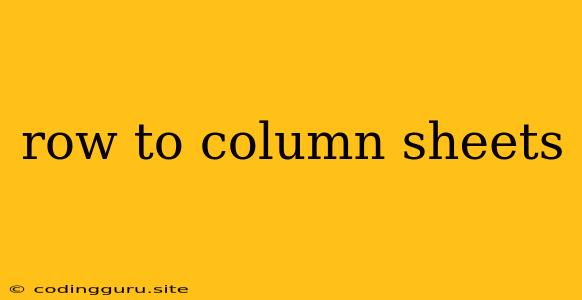Transforming Your Data: Row to Column in Google Sheets
In the world of data analysis, we often encounter datasets that are organized in a way that doesn't quite fit our needs. A common scenario is having data arranged in rows when we need it in columns, or vice versa. This is where the row to column transformation comes in handy. Google Sheets, with its intuitive interface and powerful features, offers a seamless way to reshape your data.
Let's dive into how to convert rows to columns in Google Sheets.
Why Transform Rows to Columns?
Before we get into the specifics of the transformation, let's understand why it might be necessary.
- Better Data Visualization: When data is arranged in columns, it often becomes easier to visualize trends, patterns, and relationships. This can be crucial for reports, charts, and dashboards.
- Efficient Analysis: Analyzing data in columns allows you to apply formulas, functions, and pivot tables more effectively, making it easier to extract insights.
- Streamlining Data Entry: When entering data that naturally flows in rows, having it formatted in columns can simplify the process.
Methods to Convert Rows to Columns
Google Sheets offers a couple of approaches to achieve this transformation. We'll explore both:
1. Using the TRANSPOSE Function
The TRANSPOSE function is a powerful tool that allows you to switch the rows and columns of a range of data.
Steps:
- Select the data you want to transform.
- Go to the Insert menu and choose Transpose.
- Alternatively, you can use the TRANSPOSE function directly in a cell:
Replace=TRANSPOSE(A1:B3)A1:B3with the actual range containing your data. - The TRANSPOSE function will create a new range with the rows converted to columns.
2. Using the Copy and Paste Special
This method offers a more visual approach to converting rows to columns.
Steps:
- Select the data you want to transform.
- Right-click on the selected range and choose Copy.
- Click on the top-left cell of where you want the transposed data to be located.
- Right-click on the cell and choose Paste special.
- Under Paste special, select Transpose and click OK.
Example: Transforming a List of Names
Let's illustrate with an example. Imagine you have a list of names in a column like this:
| Name | |---|---| | John Doe | | Jane Smith | | Robert Jones |
You want to convert this list to rows for a spreadsheet that requires data in a different layout.
Using TRANSPOSE:
- Select the entire column containing the names.
- Go to Insert > Transpose or use the
=TRANSPOSE(A1:A3)function (replaceA1:A3with the actual range of your data). - The result will be a row with the names as separate entries:
John Doe | Jane Smith | Robert Jones
Using Copy and Paste Special:
- Select the column of names.
- Copy the data.
- Click on the desired cell where you want the transposed data to begin.
- Paste special the data and choose Transpose.
Combining with Other Features
The row to column transformation can be combined with other Google Sheets features to create even more powerful results. For example:
- Combining with CONCATENATE: You can concatenate data from different columns into a single cell in a row. This is useful for creating labels or unique identifiers.
- Combining with VLOOKUP: You can use the
VLOOKUPfunction to retrieve data from a table based on values in the transformed columns. - Combining with Pivot Tables: You can use the transposed data to create pivot tables that provide summaries and insights across multiple columns.
Conclusion
Converting rows to columns in Google Sheets is a simple yet powerful technique. It allows you to reshape your data in a way that makes it easier to analyze, visualize, and use in other calculations. Whether you use the TRANSPOSE function or the Copy and Paste Special method, Google Sheets provides the tools you need to manipulate your data effectively. By mastering this basic transformation, you can unlock a new level of data manipulation and unlock the potential of your spreadsheets.
